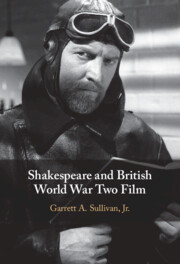Book contents
- Shakespeare and British World War Two Film
- Shakespeare and British World War Two Film
- Copyright page
- Dedication
- Contents
- Figures
- Acknowledgments
- Introduction
- Chapter 1 “Hamlet’s a Loser, Leslie”
- Chapter 2 “What We All Have in Common”
- Chapter 3 The Black-White Gentleman
- Chapter 4 “Bottom’s Not a Gangster!”
- Coda Two Cities Films and “the Spirit of Britain”
- Index
Chapter 1 - “Hamlet’s a Loser, Leslie”
Pimpernel Smith, Hamlet and Film Propaganda
Published online by Cambridge University Press: 24 March 2022
- Shakespeare and British World War Two Film
- Shakespeare and British World War Two Film
- Copyright page
- Dedication
- Contents
- Figures
- Acknowledgments
- Introduction
- Chapter 1 “Hamlet’s a Loser, Leslie”
- Chapter 2 “What We All Have in Common”
- Chapter 3 The Black-White Gentleman
- Chapter 4 “Bottom’s Not a Gangster!”
- Coda Two Cities Films and “the Spirit of Britain”
- Index
Summary
Leslie Howard’s Pimpernel Smith seeks to clarify cultural differences between the British and the Nazis by way of Shakespeare—a task complicated by German claims of the playwright’s putatively Nordic nature. This struggle over Shakespeare’s national identity is mirrored, first, in the film’s persistent emphasis on doubles; and, second, in its apparent advocacy for the notion that Edward de Vere, the 17th earl of Oxford, wrote Shakespeare’s plays. Just as Oxford appears in the film as Shakespeare’s doppelganger, Hamlet shadows both Horatio Smith (played by Howard) and Howard’s screen personae as a cerebral hero. Howard’s willingness to countenance arguments about Shakespeare’s Germanness, as well as entertain Oxfordianism, proves to be central to the film’s propaganda objectives. By contrasting Nazi intolerance for dissent with Smith’s apparent acceptance of heterodox ideas, Pimpernel Smith expresses Britain’s cultural superiority not only by way of Shakespeare, but also through Oxfordian challenges to the playwright’s identity.
Keywords
- Type
- Chapter
- Information
- Shakespeare and British World War Two Film , pp. 26 - 57Publisher: Cambridge University PressPrint publication year: 2022

